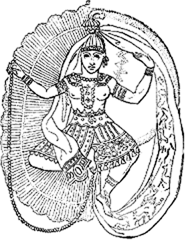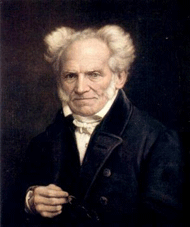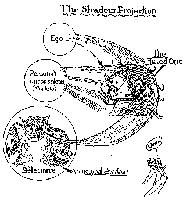Cinematic Identities... MAYA AND HER VEILS
Māyā
Her Veil And All Her Raging Beauty
per Māyām ad Majam
|
The Indians invented film. The ancient Indians. While Plato's Cave Allegory has traditionally and widely been regarded as a precursor of the filmic principle of projecting moving shadows onto a wall in the face of immobile spectators, the notion of the Web1 of Māyā, as in the Upanishads and in Vedānta religious thinking, has to my knowledge not yet been introduced into the European discourse on film.
In this text I will maintain that Māyā can serve as a fruitful metaphor or thought model for the filmic principle before the fact. It is related to the delicate motif of penetrating Māyā's Web. By piercing through her veil, the perpetrator can reach behind the surface of projections. Māyā is always understood as female and the embodiment of temptation. Her veil is an erotic metaphor, and so is the unveiling of Māyā, claimed by Schopenhauer to be leading to truth (e.g. the truth behind a film projection in our context). The claim of a violent, paradigmatically male destruction of Schein, of Māyā, her unveiling, should be regarded as a powerful fantasy of redemption, called by Schopenhauer the overcoming of the principium individuationis. In Hindi, "maya" is a colloquial term. There are common expressions like maya nagar(i), maya puri, or maya bazaar. Most often, "maya" is used in relation to the film world. In New Delhi a film magazine is published under the name of "CineMaya". On a superficial level "maya" can be compared to the American concept of Tinsel town make-believe, or to its German equivalent expression of Kintopp. However, there is a lot more, and deeper meaning to Māyā than that and the fact that it has not been used in the context of film in the Western world is quite astonishing – given the sheer amount of what and how much is continuously being written on film, on film history and on film theory. But it also comes as quite a surprise considering the history of ideas in more general terms: on the one hand the parallels between Plato's Theory of Forms (rather: of ideas, ιδέες) and the concept of Māyā were introduced into the Central European philosophical mainstream by Arthur Schopenhauer in his seminal book "Die Welt als Wille und Vorstellung2" in 1818, and have always remained there since.
|
Phenomenology: Surfing, Not Boring
It is obvious how Husserl's phenomenology relates to surfaces, planes and images. However, the surface of a phainomenon and the two-dimensional picture are not only opposed to the principle of the one-dimensional line. The phenomenological approach is also an antithesis of the method of piercing, of vertical analyses and the uncovering of deeper, hidden layers. The meaning to be dug up and disclosed from those layers is implicitly supposed to be more real or more meaningful than what can be found on the surface. This mode of thinking is most clearly represented by traditional natural sciences, by Sigmund Freud's depth psychology or by dialectical materialism. When Arthur Schopenhauer introduced his personal understanding of Māyā into the Central European tradition, it was a concept he could easily embrace in the light of both his Platonic schooling and his admiration for Immanuel Kant: Māyā could easily be Europeanized and then serve as an epistemological metaphor for the unreal results of human perception: "this [...] conception is described by the Hindus as Māyā, i.e., illusion, deception, phantasm, mirage5". Indeed, Mahamāyā is defined as "the power that throws people into the bondage of delusion and attachment [...]; the force that seizes those of knowledge and leads them to delusion6" . It cannot be denied – at least not at this rather superficial stage of comparison – that Plato's Theory of Forms, the Vedic concept of Māyā and Kantian and post-Kantian epistemology actually do share the basic opposition of "phenomenon vs. the real thing". And this is also the way Schopenhauer looked at it: by "the doctrine of Maya [...] is understood nothing but what Kant calls the phenomenon as opposed to the thing-in-itself. For the work of Maya is stated to be precisely this visible world in which we are, a magic effect called into being, an unstable and inconstant illusion without substance, comparable to the optical illusion and the dream, a veil enveloping human consciousness, a something of which it is equally false and equally true to say that it is and that it is not.7" Comparable With the Optical Illusion In Schopenhauer's interpretation, Māyā is the sheer definition of film projections before their time. It is not so much the audio-visual quality of film, nor just the sequence of two-dimensional images on a time axis of one-dimensional narration that makes Māyā comparable with the moving image but rather the principle of projection that appears to be the perfect definition of filmmaking: Māyā is the process of superimposition by which one projects one's own ignorance on the world and thus obscures ultimate truth. To wake up to the truth of things necessarily involves counteracting or overcoming māyā, which is grounded in ignorance and self-infatuation. Liberation in Hindu philosophy means to a great extent the transcendence of embodied, finite, phenomenal existence. And māyā is often equated precisely with finite, phenomenal existence. To be in the phenomenal world, to be an individual creature, is to live enveloped in māyā8. "The problem of māyā is taken by Schopenhauer to be the age-old problem of metaphysics, the relationship between what appears and what is real." In filmic terms: the reel vs. the real9. » |
----------------------------------
1. Both terms, Māyā's Veilas well as the Web of Māyā, have become well-established topoi. Although they refer to the same thing, their connotations differ slightly. "Web" as opposed to "veil" implies a more malicious, purposeful intention: a spider makes a web, because he wants to kill. A veil, however, is not an aggressive weapon but a passive, defensive means of self-protection from intrusive (male) glances. Both, however, have erotic connotations which may be more obvious in the case of the veil, but underlie the idea of a web just as well (cf. the hilarious 1966 Joi Lansing song and 16mm clip "Trapped In the Web of Love": http://www.myspace.com/video/vid/6197396).
2 English translations: R. B. Haldane and J. Kemp, "The World as Will and Idea", 1883-1886. "The World as Will and Representation" by E.F.J.Payne, 1958 (paperback editions in 1966 and 1969). Richard E. Aquila in collaboration with David Carus: "The World as Will and Presentation" (2008). It is disputable whether Schopenhauer was really the first European to fructify the Hindu concept of Māyā for the European discourse. After all, he drew on a French translation of the Upanishads from Sanskrit as well as on comments on both the Advaita Vedāntic interpretation of Māyā by their translator Abraham Hyacinthe Anquetil-Duperron and by another translator, Henry Thomas Colebrooke, and William Jones. However, the merit of having popularized the notion to such a large extent within the European academe must still be contributed to Schopenhauer. In this respect he considered himself with unusual modesty as a part of a more general tendency in which "strömt indische Weisheit nach Europa zurück und wird eine Grundveränderung in unserem Wissen und Denken hervorbringen" (Arthur Schopenhauer: Die Welt als Wille und Vorstellung. ed. Thomas Mann, Vom Geist der Grossen, vol. 1, Werner Classen, Zurich 1948, 323 – further referred to as "Die Welt als Wille und Vorstellung"), ("Indian philosophy streams back to Europe and will produce a fundamental change in our knowledge and thought", Arthur Schopenhauer: The World as Will and Idea. transl. R.B. Haldane and J. Kemp, Kegan Paul, Trench, Trübner & Co. Ltd, 7th ed., 1910, http://www.archive.org/details/theworldaswillan01schouoft, 461 – further referred to as "The World as Will and Idea").
3 Freud first mentions the psychological mechanism of projection in his letters to Wilhelm Fließ around 1897. The first spectacular public film projections in Europe had taken place in 1895 in Paris (Brothers Lumière) and Berlin (Brothers Skladanowsky).
4 "We must become superficial. It must be the surfaces and not the mysteries that are said to cover up, that must interest us. We must concentrate upon mere appearance, ('phainomenon'). Only if we desist from all explanations and significations of appearances, the surface [...] will become visible. Mystery is not hidden. It lies on the surface". Vilém Flusser: Skin. http://www.flusserstudies.net/pag/02/flusser-skin02.pdf.
5 Schopenhauer, quoted after Berger, Douglas L.: "The Veil of Māyā ": Schopenhauer's System and Early Indian Thought. Global Academic Publishing, Binghampton 2004, 191.
6 Kinsley, David: Hindu Goddesses. Vision of the Divine Feminine in the Hindu Religious Tradition. Motilal Banarsidass. Delhi, Varanasi, Patna and Madras, 1987, 100.
7 Schopenhauer, quoted after Berger, 81.
8 Kinsley, 135.
9 Berger, 80.





 Thus, Māyā has become a part of our own (European) history of ideas, albeit charged with a slightly different semantics from the one it originally had. On the other hand the obvious connection between Sigmund Freud's concept of Psychological Projection and the first projections of films, both simultaneously developed around 1895
Thus, Māyā has become a part of our own (European) history of ideas, albeit charged with a slightly different semantics from the one it originally had. On the other hand the obvious connection between Sigmund Freud's concept of Psychological Projection and the first projections of films, both simultaneously developed around 1895 Edmund Husserl was born in the Moravian small town of Proßnitz/Prostějov in 1859; Sigmund Freud was born in the Moravian small town of Freiberg/Příbor in 1856. Both men came from German-speaking Jewish middle class families. One could well maintain that their respective life projects, phenomenology and psychology/psycho-analysis, had an impact on the history of ideas that was no less dramatic than that of Darwinism and Marxism merely two generations earlier. However, in spite of the extremely similar enculturation and socialization Freud and Husserl enjoyed, phenomenology in its attempt to bracket off, to factor out, previous knowledge and to restrict itself to perceivable phenomena only on the one hand and psycho-analysis with its interest in underlying truths that need to be dug out from below a surface on the other hand are contrary concepts effecting antipodal attitudes
Edmund Husserl was born in the Moravian small town of Proßnitz/Prostějov in 1859; Sigmund Freud was born in the Moravian small town of Freiberg/Příbor in 1856. Both men came from German-speaking Jewish middle class families. One could well maintain that their respective life projects, phenomenology and psychology/psycho-analysis, had an impact on the history of ideas that was no less dramatic than that of Darwinism and Marxism merely two generations earlier. However, in spite of the extremely similar enculturation and socialization Freud and Husserl enjoyed, phenomenology in its attempt to bracket off, to factor out, previous knowledge and to restrict itself to perceivable phenomena only on the one hand and psycho-analysis with its interest in underlying truths that need to be dug out from below a surface on the other hand are contrary concepts effecting antipodal attitudes